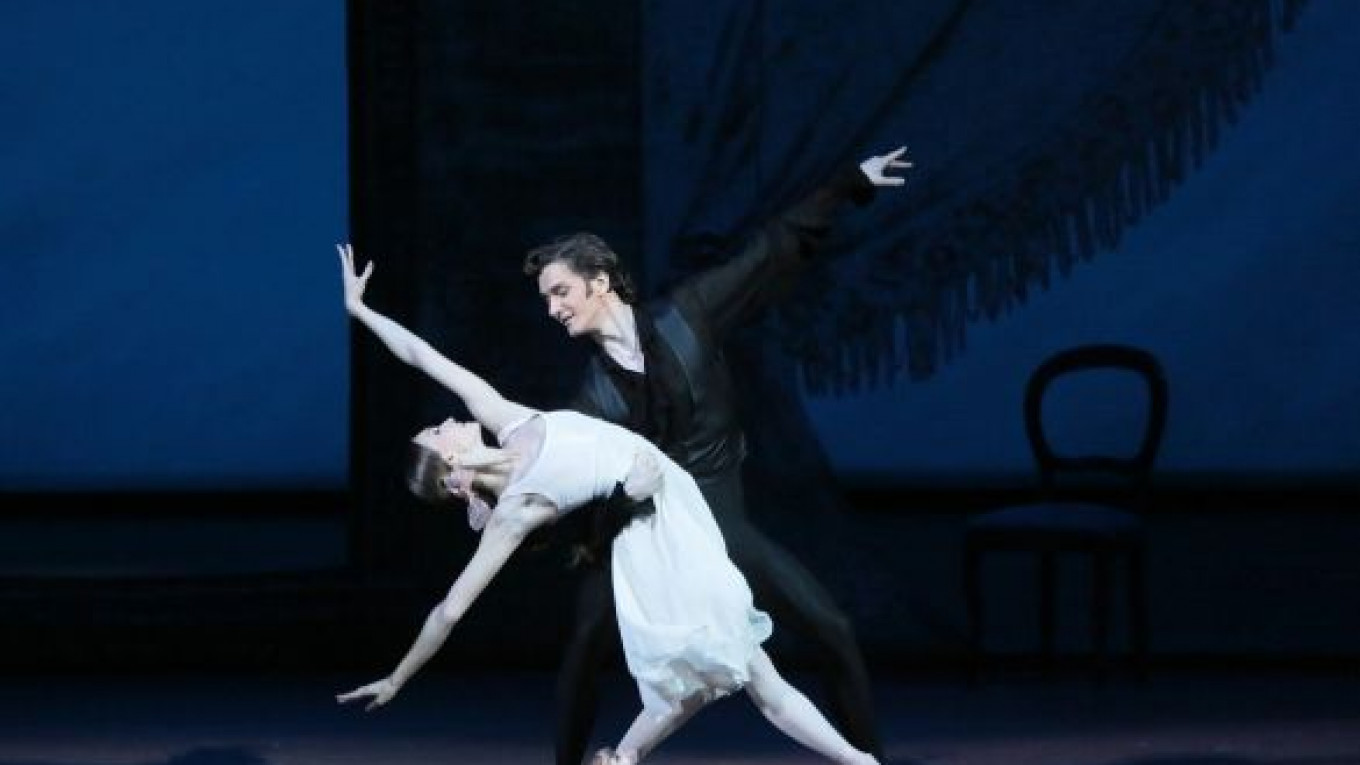It came as no great surprise, in view of the tumult within the Bolshoi Theater during recent months, to find its season-ending premiere of John Cranko's ballet "Onegin" touched by a bit of scandal.
The theater's most prominent prima ballerina, Svetlana Zakharova, apparently was told, or was promised, or simply assumed that she would appear in the lead role of Tatyana at the first of the ballet's nine scheduled performances. Shortly before the opening, however, Reid Anderson, director of Germany's Stuttgart Ballet and head of the team staging "Onegin" for the Bolshoi, decided differently, designating 21-year-old superstar-in-the-making Olga Smirnova as the first night's Tatyana. With that, an incensed Zakharova abandoned rehearsals and announced that she no longer wished to take part in the ballet.
Zakharova will probably appear in "Onegin" when it returns in the coming season and only then can we judge whether Anderson made a correct decision. What can be said for now is that Smirnova proved thoroughly entrancing both as the lovelorn teenage Tatyana of the ballet's first two acts and as the wife, 20 years later, of Prince Gremin, in the ballet's third and final act.
As is no doubt obvious from its title, "Onegin" derives from Alexander Pushkin's classic novel in verse, "Eugene Onegin," and was created in 1965 by South-African-born Cranko for the Stuttgart Ballet, the company he brought to worldwide renown as its director from 1961 until his sudden death 12 years later, at the age of 45.
Though the ballet has since been performed by numerous dance companies throughout the world, the Bolshoi's is the first-ever production in Russia.
Moscow audiences did, however, see it once before, on visit in 1972 by Cranko's Stuttgart company. The reaction then was one of ridicule, due mainly to Cranko's departures from Pushkin's text, among them the rather unconvincing introduction of Tatyana and her sister Olga into the second-act duel scene. Ridiculed as well was the score, an arrangement by German composer Kurt-Heinz Stolze of 33 pieces taken from Pyotr Tchaikovsky's orchestral music, piano works (in orchestrated form) and opera "Cherevichki."
No signs of ridicule were evident at the two Bolshoi performances of "Onegin" I attended. On the contrary, both received as long and vociferous ovations as any I have ever witnessed at the theater.
Some of Cranko's choreography, for the corps de ballet, in particular, and some of his pantomime — above all the duel between Onegin and Lensky — seemed rather commonplace. But the dance created for the ballet's five principals comes across as the work of a true choreographic genius.
The best moments of Onegin lie in its duets, especially the three involving Tatyana and Onegin, first at their meeting in the opening scene, then in a dream sequence inserted into the letter scene that immediately follows and, finally, in their heartrending farewell at the ballet's very end.
Smirnova brought to Tatyana her customary lyricism, secure technique and graceful positioning of head, arms and hands and seemed, as she has in every other role during her two seasons at the Bolshoi, to create around herself a distinctive aura that sets her apart from any other dancer I know of.
The tall, elegant Onegin of the performance was Vladislav Lantratov, whose accomplishments over the past season have marked him as one of the ballet troupe's most valuable assets.
I missed the other two Bolshoi casts, as well as a performance with five soloists of the Stuttgart Ballet in the principal roles and a final evening that saw American David Hallberg return to the Bolshoi stage after a year's absence due to injury.
I did, however, have the pleasure of seeing Tatyana and Onegin danced by two distinguished guests of the Bolshoi, the Mariinsky Theater's Diana Vishneva and Brazilian-born Marcelo Gomes, in a performance polished by their appearances together in the roles with New York-based American Ballet Theater.
In Vishneva's interpretation of Tatyana was that same technical precision, beauty of movement and radiant personality that have captivated me so often over the past decade and more. And somewhat to my surprise, she managed, having just turned 36, to give a near-perfect portrayal of a girl less than half her age. It is perhaps worth noting that both Smirnova and Vishneva are graduates of St. Petersburg's Vaganova Russian Academy of Ballet, where both trained, a decade and a half apart, with the very same teacher.
Gomes gave a strong, confident and beautifully nuanced account of Onegin. Once again, as in his previous appearances in Moscow with Vishneva, he struck me as coming as close as anyone possibly could to being her ideal partner.
"Onegin" next appears on Oct. 10 and 11 at 7 p.m. and Oct. 12 at 12 noon and 7 p.m. on the Main Stage of the Bolshoi Theater, located at 1 Teatralnaya Ploshchad. Metro Teatralnaya. Tel. 8-495-455-5555. bolshoi.ru
Contact the author at [email protected]
Related articles:
A Message from The Moscow Times:
Dear readers,
We are facing unprecedented challenges. Russia's Prosecutor General's Office has designated The Moscow Times as an "undesirable" organization, criminalizing our work and putting our staff at risk of prosecution. This follows our earlier unjust labeling as a "foreign agent."
These actions are direct attempts to silence independent journalism in Russia. The authorities claim our work "discredits the decisions of the Russian leadership." We see things differently: we strive to provide accurate, unbiased reporting on Russia.
We, the journalists of The Moscow Times, refuse to be silenced. But to continue our work, we need your help.
Your support, no matter how small, makes a world of difference. If you can, please support us monthly starting from just $2. It's quick to set up, and every contribution makes a significant impact.
By supporting The Moscow Times, you're defending open, independent journalism in the face of repression. Thank you for standing with us.
Remind me later.






